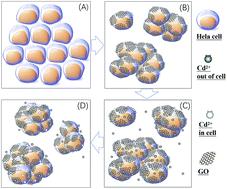当前位置:
X-MOL 学术
›
Toxicol. Res.
›
论文详情
Our official English website, www.x-mol.net, welcomes your feedback! (Note: you will need to create a separate account there.)
Characteristic synergistic cytotoxic effects toward cells in graphene oxide dressing with cadmium and copper ions
Toxicology Research ( IF 2.1 ) Pub Date : 2019-09-16 , DOI: 10.1039/c9tx00146h Yiyang Dong 1 , Yulin Chang 1 , Haidi Gao 1 , Victoria Arantza León Anchustegui 1 , Qiang Yu 1 , Haifang Wang 2 , Jia-Hui Liu 1, 3 , Shihui Wang 1
Toxicology Research ( IF 2.1 ) Pub Date : 2019-09-16 , DOI: 10.1039/c9tx00146h Yiyang Dong 1 , Yulin Chang 1 , Haidi Gao 1 , Victoria Arantza León Anchustegui 1 , Qiang Yu 1 , Haifang Wang 2 , Jia-Hui Liu 1, 3 , Shihui Wang 1
Affiliation

|
The increasing applications of graphene oxide (GO) in bio-medicine, environment and other fields enhance the exposure possibility of human beings to GO. Studies have been performed to address the in vitro toxicity of GO; however, little information on the in vivo biological consequence of GO with other common disasters is available, especially when cells are co-exposed to GO and common metal ions. To explore the influence and possible mechanisms of such co-exposure scenarios, a series of tests of cell viability, membrane integrity, reactive oxygen species (ROS), cell morphology, and Cd2+ distribution, were conducted. The results showed that the synergistic toxic mechanisms of GO and Cd2+, initiated from the adhesion of GO on HeLa cells, and followed by the recruitment of Cd2+ ions around the cell membrane, impaired the membrane integrity, morphology and adhesion capability, and triggered cell toxicity. The synergistic toxic mechanism of GO and Cu2+ mainly correlated to ROS, while no obvious relationship with membrane integrity was observed. The findings are envisaged to facilitate the application of GO in biology and related fields.
中文翻译:

含镉和铜离子的氧化石墨烯敷料对细胞的特征性协同细胞毒性作用
氧化石墨烯(GO)在生物医学,环境和其他领域中的越来越多的应用增加了人类接触GO的可能性。已经进行了研究以解决GO的体外毒性。但是,关于GO与其他常见灾害的体内生物学后果的信息很少,尤其是当细胞与GO和常见金属离子共同暴露时。为了探索这种共同暴露场景的影响和可能的机制,进行了一系列细胞活力,膜完整性,活性氧(ROS),细胞形态和Cd 2+分布的测试。结果表明GO和Cd 2+的协同毒性机制,其起因于GO在HeLa细胞上的粘附,然后在细胞膜周围募集Cd 2+离子,损害了膜的完整性,形态和粘附能力,并引发了细胞毒性。GO和Cu 2+的协同毒性机制主要与ROS有关,而与膜完整性没有明显的关系。设想该发现将促进GO在生物学和相关领域中的应用。
更新日期:2019-09-16
中文翻译:

含镉和铜离子的氧化石墨烯敷料对细胞的特征性协同细胞毒性作用
氧化石墨烯(GO)在生物医学,环境和其他领域中的越来越多的应用增加了人类接触GO的可能性。已经进行了研究以解决GO的体外毒性。但是,关于GO与其他常见灾害的体内生物学后果的信息很少,尤其是当细胞与GO和常见金属离子共同暴露时。为了探索这种共同暴露场景的影响和可能的机制,进行了一系列细胞活力,膜完整性,活性氧(ROS),细胞形态和Cd 2+分布的测试。结果表明GO和Cd 2+的协同毒性机制,其起因于GO在HeLa细胞上的粘附,然后在细胞膜周围募集Cd 2+离子,损害了膜的完整性,形态和粘附能力,并引发了细胞毒性。GO和Cu 2+的协同毒性机制主要与ROS有关,而与膜完整性没有明显的关系。设想该发现将促进GO在生物学和相关领域中的应用。


























 京公网安备 11010802027423号
京公网安备 11010802027423号